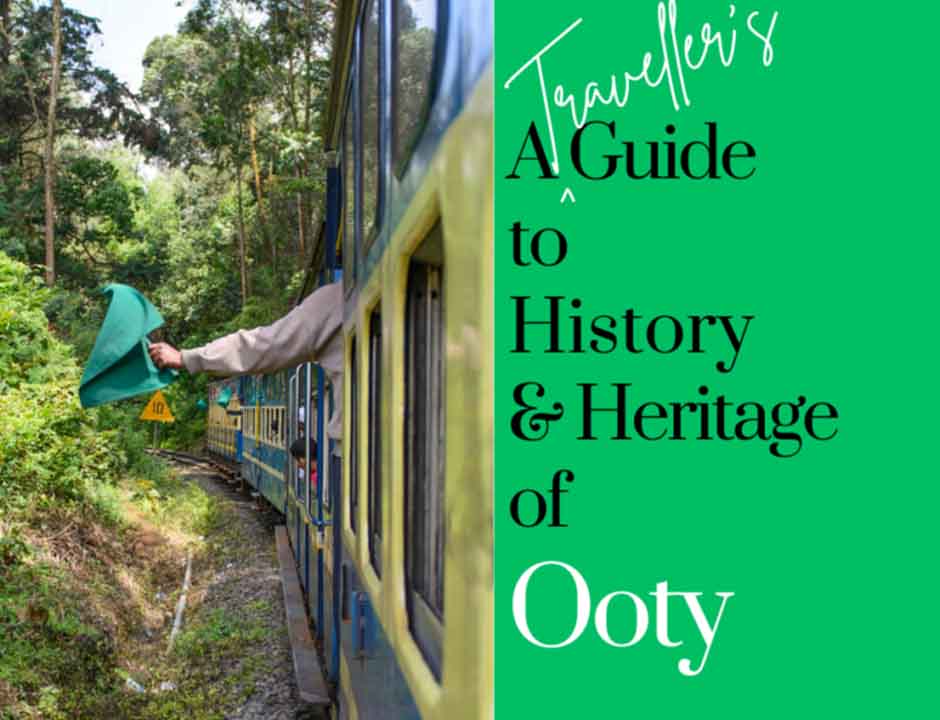Best Historical & Heritage Hotels in Ooty
[related_property_horizontal destination="ooty"]

Ooty, also known as Udhagamandalam, is a picturesque hill station on the Nilgiri ( Nilgiri means Blue Hills)of Western Ghats in Tamil Nadu, India. The modern history of Ooty is believed to begin in the 17th century with the British East India Company’s commercial interest in the region.
But a well-known travel blog, www.pallyplanet.com points out that Christian messengers sent by the Portuguese from Kerala were the first outsiders to visit the blue hills.
The region was inhabited by the Toda tribe, who were skilled in dairy farming and agriculture. The Toda people continue to reside in Ooty to this day and are an integral part of the local culture and history.
Ooty was established as a hill station by the British in the early 19th century, and it soon became a popular summer retreat for British officials stationed in South India. You can see many colonial-era buildings, such as the Ooty Club, St. Stephen’s Church, and the Government House.
The Nilgiri Mountain Railway, a UNESCO World Heritage Site, is the most iconic colonial-era structure currently present in Ooty. Unfortunately, the authorities are not utilizing the tremendous heritage railway tourism opportunities.
Ooty is home to a diverse range of communities, including the Toda, Badaga, and Kota tribes, each with its unique cultural practices and traditions. During our trip to Ooty, we visited a small village near the town and witnessed a group of artisans and sculptors create idols and utensils out of rock and boulders. Additionally, Ooty is known for its tea plantations, an industry that has played a significant role in the region’s cultural and economic history.
Finally, due to its status as a former British military base and colonial-era hill station, Ooty has also adopted certain aspects of British culture and architecture, which can be seen in the town’s many colonial-era buildings and landmarks.
The first port of arrival for your Ooty journey is Coimbatore in Tamil Nadu, which can be accessed by air or train. The Coimbatore International Airport (CJB) is approximately 90 km/55 miles from Ooty. If you can secure a ticket on the Nilgiri Mountain Railway from Mettupalayam (a small town at the foothills of the Ooty hills), we advise you to travel by taxi to Mettupalayam and continue your journey on the historic train to Ooty.
Please note that the Mountain train will often be fully booked days in advance, so it is best to plan accordingly and book tickets early. You can find more information about the train and how to book tickets at the following website: https://www.irctchelp.in/nilgiri-mountain-railway/.
a) Government House: The official residence of the Governor of Tamil Nadu, built-in 1820, is a beautiful example of colonial architecture.
b) St. Stephen’s Church: A neo-Gothic church built in 1829, famous for its beautiful stained-glass windows and intricate woodwork.
c) Ooty Botanical Gardens: Established in 1848, the gardens house a vast collection of exotic plants and trees.
d) Doddabetta Peak: The highest peak in the Nilgiri Mountains, offering breathtaking views of the surrounding landscape.
e) Stone House: One of the oldest buildings in Ooty, built-in on land purchased from the Toda people by paying Rs 560. The year of construction is 1822.
f) Toda Huts: The traditional homes of the Toda tribe, known for their unique architecture and intricate embroidery work.
g) Nilgiri Mountain Railway: A UNESCO World Heritage Site, offering a scenic journey through the picturesque Nilgiri Mountains on a “Steam Engine” locomotive.
Ooty offers many tourist attractions besides historical and heritage sites, including Pykara Falls, Emerald Lake, Avalanche Lake, and the Rose Garden. If you are never to a tea plantation before, we suggest you spend some time in a tea plantation taking fresh air, examining the tea plants and leaves, learning how workers pluck the tea leaves etc. We also recommend you allocate some time and energy to learn about how different types of teas, such as black tea, green tea, white tea etc.
If you prefer cold weather, winter is the best time to visit Ooty. However, but prefer a pleasant weather, summer is ideal. Avoid visiting during school holidays or the Ooty flower show schedules, as these occasions can be crowded.
One art form worth experiencing in Ooty is Toda embroidery, which features intricate geometric patterns and bright colours. You can also witness the Badaga dance, a traditional dance form of the Badaga tribe that involves synchronized movements along a rhythmic beat.
Tea is a popular souvenir item, with various teas available for purchase. Other popular souvenirs include Toda embroidery, shawls, and handicrafts by local artisans.
There is nothing in particular, but we had the opportunity to visit a Toda village and try Otidoor, a rice-based dish with them. It was a great experience. Check with your guide about the possibility of seeing a Toda village and sampling their traditional food- only if you are interested in extreme cultural experiments.
Did you know that Ooty is home to the first-ever chocolate factory in India, established in 1947?
Though Snooker was invented in Jabalpur by British army officials in 1875, the game rules were formulated in Ooty. The first game played as per the rules was at the Ooty Club. Ketti is a valley in Ooty and the largest inhabited valley in Asia.
To fully explore Ooty, visitors should plan to spend at least three days in the town.
If you want to learn about British colonial history and visit a tea plantation town still surviving on its colonial-era glory, we suggest including Ooty in your itinerary.
We have identified a few historical hotels that are worth staying in when you are in Ooty. Please click on the icons below to get more information about them.